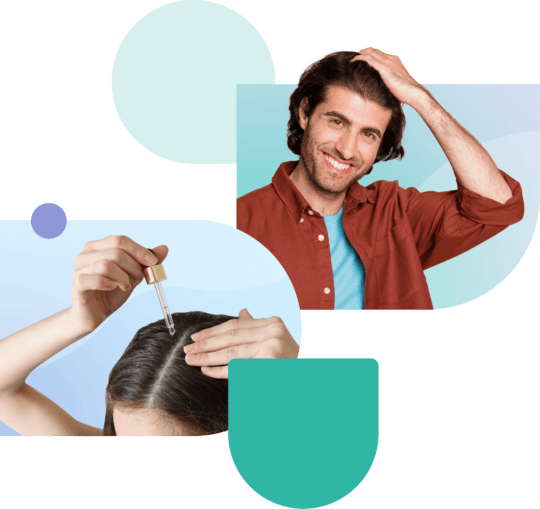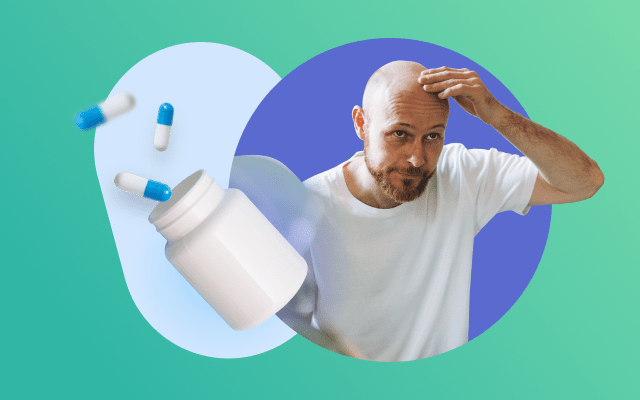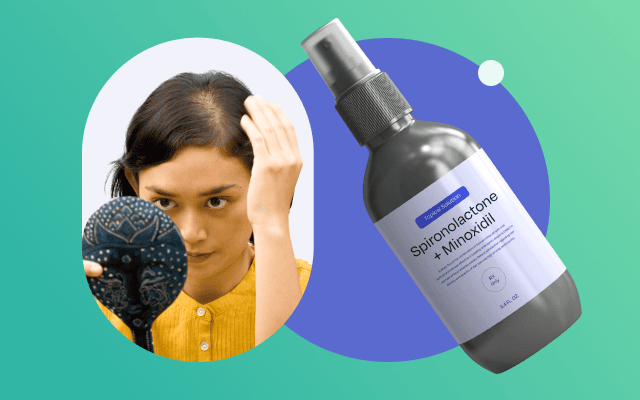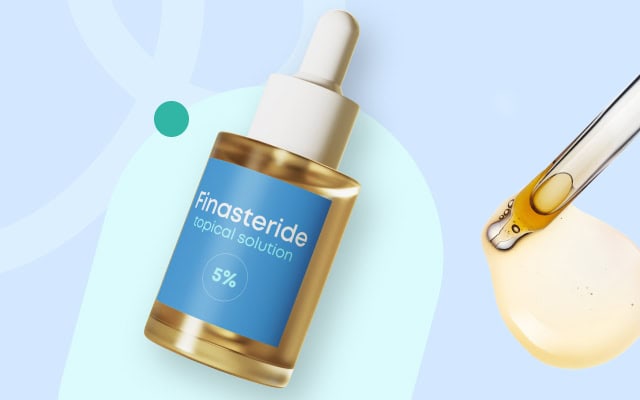Finasteride for women: What the research and experts reveal
Dr. Carolina Fernandez Quiroga, Professor of Dermatology, talks about the controversial use of finasteride for women, when it is adequate and alternative treatment options.
Table of Content:
What is finasteride? | How to get a prescription? | Alternative hair loss treatments for women | Research | Side-effects | FAQs
Our commitment to producing high-quality content:
The information presented in this article is based on scientific research and the professional advice of our Content Medical Reviewers, who are experts in the field of Dermatology. How we write our content →
What is finasteride and how does it work for hair loss?
Dr. Carolina Fernandez, Professor of Dermatology, says that finasteride is a medication that primarily treats androgenic alopecia (pattern hair loss) by inhibiting the activity of the enzyme 5-alpha-reductase. This enzyme converts testosterone into dihydrotestosterone (DHT), a hormone that can cause hair follicles to shrink, leading to hair loss. By reducing DHT levels, finasteride helps to slow down hair loss and can even promote the regrowth of hair in some individuals1.
Is it safe for women to use finasteride for hair loss?
The safety and efficacy of finasteride for women, especially of childbearing age, are subjects of ongoing research and debate2.
Can oral finasteride be used by women?
Dr. Fernandez says that oral finasteride is not approved by the FDA for women of childbearing age due to the high-risk of birth defects. Finasteride is teratogenic, which means it can cause feminization of a male fetus if a woman is exposed to it during pregnancy3.
Can topical finasteride be used by women?
Dr. Fernandez says that women with androgenetic alopecia who are not pregnant and are using effective contraception could use topical finasteride. There is emerging evidence suggesting that topical finasteride may be safer for women as it has a localized effect and less systemic absorption compared to the oral form. However, its safety and long-term effects are not as well established as for men. It is crucial for these women to consult with their online dermatologist to determine if topical finasteride is suitable and safe for their particular condition.
How to get hair loss treatment online via Miiskin?
If you want to get hair loss treatment online, you can have an online consultation with a board-certified dermatologist via Miiskin for only $59. Medication refills are only $39.
Are there alternative hair loss treatments for women?
Dr. Fernandez says that hair loss in women can be effectively managed with several alternative treatments. Two commonly recommended options are spironolactone and minoxidil, both available in oral and topical forms. Here’s an overview of how these treatments work and their benefits.
Oral Spironolactone
Mechanism of action: Spironolactone is an anti-androgen medication that works by blocking androgen receptors and reducing the production of androgens, which can contribute to hair loss in women.
Uses: In dermatology it is primarily prescribed for women with androgenetic alopecia hormonal acne and hirsutism (excessive hair in areas where women don’t usually have hair).
Benefits: Helps reduce hair thinning and can improve hair density over time.
Considerations: It can cause side effects like increased urination, breast tenderness, and menstrual irregularities. It is not suitable for pregnant women or women who wish to become pregnant due to potential risks to the fetus.
Topical Spironolactone
Mechanism of action: Similar to the oral form, topical spironolactone acts locally to block androgen receptors in the scalp.
Uses: Applied directly to the scalp to target hair loss with fewer systemic side effects compared to the oral form.
Benefits: Can reduce hair thinning and promote hair regrowth with a lower risk of systemic side effects.
Considerations: Less commonly used and studied compared to oral spironolactone, and its effectiveness may vary.
Oral Minoxidil
Mechanism of action: Originally developed as a blood pressure medication, oral minoxidil has been found to promote hair growth by widening blood vessels and improving blood flow to hair follicles.
Uses: Prescribed off-label for hair loss in men and women when topical treatments are insufficient.
Benefits: Can result in significant hair regrowth and improved hair density.
Considerations: Potential side effects include dizziness, fluid retention, and increased heart rate. The most common side effect of oral minoxidil use is increased hair growth in unwanted areas (a condition called “hypertrichosis”). Close monitoring by a healthcare professional is essential.
Topical minoxidil
Mechanism of action: Applied directly to the scalp, topical minoxidil stimulates hair follicles, prolongs the anagen (growth) phase of the hair cycle, and increases hair follicle size.
Uses: Widely used and FDA-approved for treating female pattern hair loss. Available in various strengths, commonly 2% and 5% solutions or foam.
Benefits: Helps reduce hair shedding, promotes regrowth, and increases hair density with consistent use.
Considerations: Initial shedding may occur as new hair growth cycles begin. Side effects can include scalp irritation or dryness. Results typically become noticeable after 3-6 months of consistent use.
What the research says about using finasteride for women as hair loss treatment
A study conducted revealed that 5 mg/day finasteride is effective in women and that side-effects were rare, mild, and transient; include headache, menstrual irregularities, dizziness, increased body hair growth, and decreased libido4.
Another study revealed that 62% of patients taking 2.5 mg/day oral finasteride showed improvement and 12 patients had a significant increase in hair density5.
A third study showed that in-spite of the risks, finasteride, shows potential as an alternative treatment for female pattern loss, however its use in women is limited due to potential teratogenic effects6.
What our expert dermatologist recommends
Although studies show that oral finasteride is effective in the treatment of hair loss for women, Dr. Carolina Fernandez, recommends it is only used by post-menopausal or those who cannot become pregnant due to its teratogenic effects.
For women of childbearing age, she recommends using an alternative treatment such as spironolactone and/or minoxidil in oral or topical form.
If a woman takes oral finasteride, how long does she need to wait to get pregnant?
According to Dr. Fernandez, after discontinuing oral finasteride, a woman should wait at least 30 days before attempting to become pregnant. This ensures the medication is adequately eliminated from the body and to minimize any potential risks to the fetus.
The elimination half-life of finasteride is approximately 5-6 hours in younger individuals and can be longer in older adults. Given this, it typically takes around one month for the drug to be effectively cleared from the body7.
Finasteride side-effects for women
Finasteride is primarily used to treat male pattern baldness and benign prostatic hyperplasia. Its use in women for treating hair loss, has been less common due to potential risks and the need for more research. Below is an overview of the side-effects of finasteride for women.
Teratogenic effects
Finasteride can cause severe birth defects, particularly in the development of male fetuses. Women who are or may become pregnant should avoid taking the medication altogether and should not handle crushed or broken finasteride tablets.
Menstrual irregularities
Some women may experience changes in their menstrual cycles, including irregular periods.
Breast changes
Finasteride can cause breast tenderness, enlargement, or even the development of benign breast lumps.
Sexual dysfunction
Some women may experience a decrease in libido (sexual desire) and there have been reports of other sexual side effects, although these are less common and less well-studied in women compared to men.
Mood and mental health
There have been reports linking finasteride to mood changes, depression, and anxiety, though these effects are not fully understood and are still being studied.
Fatigue
Some women may feel unusually tired or fatigued while taking finasteride.
Headaches
Headaches can occur as a side effect of the medication.
Acne
Finasteride can cause acne in women due to its hormonal effects8.
Is finasteride dangerous for women?
Dr. Fernandez says that finasteride can be dangerous for women, particularly those who are or may become pregnant, due to its teratogenic effects. For postmenopausal women or those who cannot become pregnant, it may be prescribed off-label for hair loss, but this use should be closely monitored by a healthcare provider due to potential side effects9.
What is the typical dose of finasteride for women?
Finasteride has been demonstrated to be effective at a dose of 1 mg/day for the treatment of male pattern alopecia; however, its efficacy in females remains more contentious (higher doses may be used). When prescribed to women of childbearing age, it is essential to co-administer it with contraceptives. This use should be carefully monitored by a healthcare provider, particularly to manage potential side effects and ensure the treatment is appropriate for the individual’s specific condition and health status.
Frequently asked questions about finasteride for women
Can finasteride be used in females?
Finasteride is not FDA-approved for women due to potential risks, particularly teratogenic effects. In some cases it could be used in females, particularly postmenopausal women or those who are not at risk of becoming pregnant. However, there are other efficient treatments for hair loss that have less adverse side-effects10.
What is better for female hair loss, finasteride or spironolactone?
Dr. Fernandez says that spironolactone is often preferred for women as it has a better-established safety profile. Besides being used for hair loss, spironolactone is also commonly used to treat hair loss, acne and hirsutism in women.
How long does it take for finasteride to work for women?
Dr. Fernandez says that finasteride typically takes 3 to 6 months to show noticeable results in reducing hair loss and promoting hair regrowth. Full effects can take up to a year to become evident.
What are the long-term effects of finasteride on women?
Dr. Fernandez says that the long-term use of finasteride in women is not well-studied. Potential long-term effects may include: hormonal changes, menstrual irregularities, breast changes (such as tenderness, or enlargement), mood changes and mental health effects11.
What is the success rate of finasteride in women?
Some studies suggest that it can be effective in reducing hair loss and promoting regrowth, particularly in postmenopausal women, but results are mixed and not as well-established as in men12 13 14 .
Does finasteride increase horniness?
Dr. Fernandez says that there is no evidence to suggest that finasteride increases libido (horniness). In fact, some users report decreased libido as a side effect15.
Does finasteride increase breast size?
Finasteride can potentially cause breast tenderness and enlargement in some women due to its effects on hormone levels, but effects are not permanent16.
Why is finasteride banned?
Dr. Fernandez says that finasteride is not banned, its use is restricted in certain individuals due to the risk of side-effects and its teratogenic effects. Women are advised to avoid any exposure during pregnancy.
Does finasteride affect sleep?
Dr. Fernandez says that there is limited evidence to suggest that finasteride directly affects sleep. However, mood changes and other side effects may indirectly impact sleep quality for some individuals17.
Does finasteride affect mood?
Finasteride has been associated with mood changes, including depression and anxiety, although these effects are not fully understood and are still being studied. Some users report mood-related side effects, while others do not experience any significant changes18.
Does finasteride re-grow hair?
Finasteride “re-grows hair” by inhibiting the action of an enzyme called 5-alpha-reductase, which converts testosterone into dihydrotestosterone (DHT). DHT is a potent androgen, or male hormone, that plays a significant role in the development of male pattern baldness
Key points of the article
- Mechanism of action: Finasteride treats androgenic alopecia (pattern hair loss) by inhibiting the enzyme 5-alpha-reductase, reducing dihydrotestosterone (DHT) levels, slowing hair loss, and promoting hair regrowth.
- Safety concerns for women: Oral finasteride is not FDA-approved for women of childbearing age due to high risk of birth defects. Topical finasteride may be safer but lacks extensive research on long-term effects.
- Alternative treatments: Women can use treatments like spironolactone and minoxidil in oral or topical forms to manage hair loss effectively. Spironolactone blocks androgen receptors, while minoxidil stimulates hair growth.
- Research findings: Studies show oral finasteride can be effective for women, with reported improvements in hair density. However, its use is limited due to teratogenic effects, making it suitable primarily for postmenopausal women or those not planning to become pregnant.
- Side effects: Finasteride can cause teratogenic effects, menstrual irregularities, breast changes, sexual dysfunction, mood changes, fatigue, headaches, and acne in women. It should be avoided by women who are or may become pregnant.
Do you think you need a prescription for hair loss? Consult a board-certified dermatologist!
Article References:
https://www.ncbi.nlm.nih.gov/books/NBK513329/
https://www.pdr.net/drug-summary/?drugLabelId=Propecia-finasteride-378#pregnancy-and-lactation
https://www.ncbi.nlm.nih.gov/pmc/articles/PMC5803857/
https://jamanetwork.com/journals/jamadermatology/fullarticle/403800
https://www.ncbi.nlm.nih.gov/pmc/articles/PMC7060023/
https://www.ncbi.nlm.nih.gov/pmc/articles/PMC5803857/
https://jamanetwork.com/journals/jamadermatology/fullarticle/403800
Hair loss articles
Reviewed by dermatologists
Using oral minoxidil at a low dose for hair loss
Is alopecia genetic or hereditary?
How to stop alopecia areata from spreading?
Does creatine cause hair loss?
Which vitamin deficiency ACTUALLY causes hair loss?
Can I use a derma roller with minoxidil for enhanced hair growth?






 Have a hair loss consultation
Have a hair loss consultation